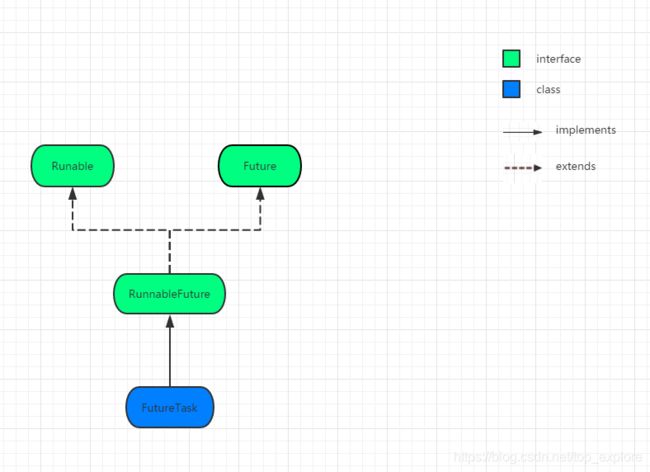java.util.concurrent学习(四) FutureTask
FutureTask是一个实现了RunnableFuture的任务类,而RunnableFuture又同时继承了Runable,Future接口,那么这就说明,FutureTask同时具备了Runable,Future的属性。
FutureTask生命周期
FutureTask内部维护了Callable
private static final int NEW = 0; 新建
private static final int COMPLETING = 1; 正在完成
private static final int NORMAL = 2; 已完成
private static final int EXCEPTIONAL = 3; 异常
private static final int CANCELLED = 4; 已取消
private static final int INTERRUPTING = 5; 正在打断
private static final int INTERRUPTED = 6; 已打断NEW
从构造方法中可以看到,FutureTask通过Executors.callable(runnable, result)的方法实现了可以构造Callable,Runable两种任务的构造方法。构造方法调用以后,将FutureTask状态置为NEW,表示一个任务已建立,等待执行。
public FutureTask(Callable callable) {
if (callable == null)
throw new NullPointerException();
this.callable = callable;
this.state = NEW; // ensure visibility of callable
}
public FutureTask(Runnable runnable, V result) {
this.callable = Executors.callable(runnable, result);
this.state = NEW; // ensure visibility of callable
} COMPLETING
通过执行run方法来进入该状态。
public void run() {
//不处于new状态 或者 通过UnSafe的CAS操作无法将本对象的runnerOffset从null指向当前线程 则不执行
if (state != NEW ||
!UNSAFE.compareAndSwapObject(this, runnerOffset,
null, Thread.currentThread()))
return;
try {
Callable c = callable;
if (c != null && state == NEW) {
V result;
boolean ran;
try {
//执行任务
result = c.call();
ran = true;
} catch (Throwable ex) {
result = null;
ran = false;
//任务异常
setException(ex);
}
if (ran)
//结束任务
set(result);
}
} finally {
// runner must be non-null until state is settled to
// prevent concurrent calls to run()
runner = null;
// state must be re-read after nulling runner to prevent
// leaked interrupts
int s = state;
//如果处于正要打断或已打断的状态 则让出cpu
if (s >= INTERRUPTING)
handlePossibleCancellationInterrupt(s);
}
} NORMAL
protected void set(V v) {
//将任务从NEW更新为COMPLETING状态
if (UNSAFE.compareAndSwapInt(this, stateOffset, NEW, COMPLETING)) {
outcome = v;
//改为NORMAL
UNSAFE.putOrderedInt(this, stateOffset, NORMAL); // final state
//完成
finishCompletion();
}
}EXCEPTIONAL
protected void setException(Throwable t) {
//任务从NEW更新为COMPLETING
if (UNSAFE.compareAndSwapInt(this, stateOffset, NEW, COMPLETING)) {
outcome = t;
//改为EXCEPTIONAL
UNSAFE.putOrderedInt(this, stateOffset, EXCEPTIONAL); // final state
//完成
finishCompletion();
}
}CANCELLED / INTERRUPTING / INTERRUPTED
public boolean cancel(boolean mayInterruptIfRunning) {
//如果状态处于NEW 则根据mayInterruptIfRunning来决定原子更新为INTERRUPTING或者CANCELLED
//如果状态不为NEW,或者无法从NEW转为INTERRUPTING或CANCELLED,则返回false。
if (!(state == NEW &&
UNSAFE.compareAndSwapInt(this, stateOffset, NEW,
mayInterruptIfRunning ? INTERRUPTING : CANCELLED)))
return false;
try {
// in case call to interrupt throws exception
//如果mayInterruptIfRunning为true,则正在执行的线程也会打断
if (mayInterruptIfRunning) {
try {
Thread t = runner;
if (t != null)
t.interrupt();
} finally {
// final state
//最后更新为INTERRUPTED
UNSAFE.putOrderedInt(this, stateOffset, INTERRUPTED);
}
}
} finally {
finishCompletion();
}
return true;
}从这几个状态更新的方法我们可以看出FutureTask可能有的生命周期:
几个额外的方法
runAndReset();该方法会执行任务但不会更新任务状态并返回结果,除非发生异常,如果任务执行并且处于NEW的状态则返回ture。
awaitDone(boolean timed, long nanos);限时等待任务执行完成。
get();通过report(s)获取返回值,从上面的run方法可以看出,该方法获取到的可能是异常。
get(long timeout, TimeUnit unit); 限时获取返回值。通过awaitDone(boolean timed, long nanos)来限时。

